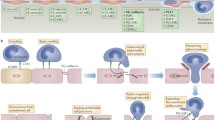Abstract
Since the function of WBC is mainly fullfilled in the extra-vascular tissue, these cells have to emigrate from the circulation which is only used as a transport system. Before active emigration can take place the leukocytes must be in a position where they can interact with the endothelium through which they penetrate. This interaction can only be established if the WBC travel close to the vessel wall. Therefore the phenomenon of margination must be considered as a first step in the series of events constituting leukocyte extravasation. Since active locomotion of WBC within the flowing blood is impossible, leukocytes must be passively displaced towards the endothelial surface. This displacement can be favored or inhibited by the hydrodynamic and rheological flow conditions (1). Even if the mechanism of WBC-margination and the following steps leading to emigration are not yet fully understood, it is well known that these phenomena occur mainly in the small venules of the microcirculation (2, 8).
Access this chapter
Tax calculation will be finalised at checkout
Purchases are for personal use only
Preview
Unable to display preview. Download preview PDF.
Similar content being viewed by others
References
GRANT, L. (1973) The sticking and emigration of WBC in inflammation. The Inflammatory Process 2: 205–249
KROGH, A. (1929) The anatomy and physiology of capillaries New York, Hafner
NOBIS, U., Gaehtgens, P. (1981) Rheology of WBC during blood flow through narrow tubes. Bibl. anat. 20: 211–214
PALMER, A. A. (1967) Platelet and leukocyte skimming. Bibl. anat. 9: 300–303
PHIBBS, R. H. (1966) Distribution of leukocytes in blood flowing through arteries. Am. J. Physiol. 210: 919–925
SCHMID-SCHÖNBEIN, G. W., Usami, S., Skalak, R., Chien, S. (1980) The interaction of leukocytes and erythrocytes in capillary and postcapillary vessels. Microvasc. Res. 14: 45–70
VEJLENS, G. (1938) The distribution of leukocytes in the vascular system. Acta path. microbiol. scand. 33: 11–239
ZWEIFACH, B. W. (1961) Functional behaviour of the microcirculation. Springfield III, Thomas, p. 95
Editor information
Editors and Affiliations
Rights and permissions
Copyright information
© 1982 Springer Science+Business Media Dordrecht
About this chapter
Cite this chapter
Nobis, U., Pries, A.R., Gaehtgens, P. (1982). Rheological Mechanisms Contributing to WBC-Margination. In: Bagge, U., Born, G.V.R., Gaehtgens, P. (eds) White Blood Cells. Microcirculation Reviews, vol 1. Springer, Dordrecht. https://doi.org/10.1007/978-94-009-7585-9_7
Download citation
DOI: https://doi.org/10.1007/978-94-009-7585-9_7
Publisher Name: Springer, Dordrecht
Print ISBN: 978-94-009-7587-3
Online ISBN: 978-94-009-7585-9
eBook Packages: Springer Book Archive




